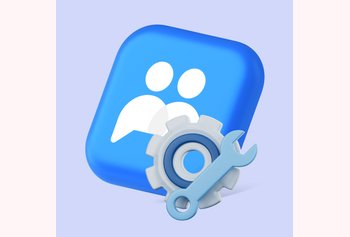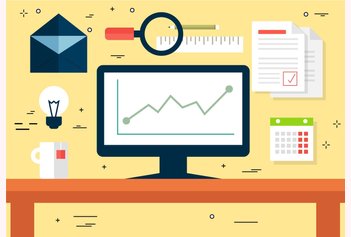9 Essential Outlook Tips and Tricks to Boost Email Productivity
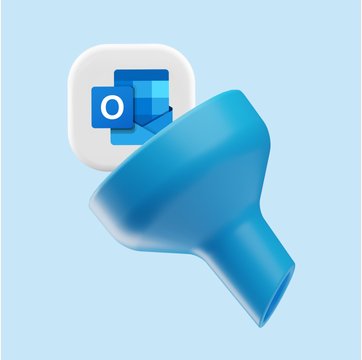
Table of contents
If there’s anything I’ve learnt using Outlook over the years, it’s that it is an extremely powerful email service that most people don’t take full advantage of.
There are so many hidden features that can streamline the way you manage your emails and calendar. But most people are unaware of this.
If you’re like me and want to do more with less effort, you’re in the right place. In this article, I’ll talk about 9 of the best tips and tricks you should know to become an Outlook power-user.
Let’s dive in.
Table of Contents
- 9 Outlook Tips to Implement in 2025 to Maximize Your Productivity
- 1. Organize your emails into folders
- 2. Leverage Outlook’s Rules Feature
- 2. Draft emails faster using Outlook’s My Templates feature
- 3. Use a Focused Inbox
- 4. Learn Outlook shortcuts
- 5. Customize your swipe options
- 6. Ignore conversations that aren’t relevant
- 7. Catch up on your emails on the go
- 8. Use the do-not-disturb feature liberally
- 9. Block Spam Email Senders
- Wrapping Up
9 Outlook Tips to Implement in 2025 to Maximize Your Productivity
Here are 9 of my favourite tips for Outlook, to help you unlock its fullest potential.
1. Organize your emails into folders
Let’s begin with a very simple but impactful tip – organize your emails into folders. If your experience has been anything like mine, you get dozens of emails a day. And if you simply skim through them and leave them, you’ll quickly find yourself staring at a cluttered inbox that’s impossible to work with. Want to find an important detail in an email you remember receiving? It’s going to be a time suck.
Which is why I recommend taking the time to organize your emails into a folder system. Here’s how you can create new folders in Outlook.
a. Right-click your name in the Folder Pane and select ‘New Folder’. Or, right-click Inbox to add a folder inside the Inbox and select ‘New Folder’.

b. Type a name for the folder and press enter.
c. Open the folder. Now if you want to move an email into a folder, simply select an email and drag and drop it into the folder. If you want to move multiple emails at once, hold down the control key and drag to select multiple emails and then drag and drop.
d. You can also create subfolders within folders by right-clicking on the folder.
Using folders will help you categorize and prioritize your emails, and make it easier to find important messages quickly. Once you’ve created these folders based on how you want to divide incoming messages, you can use Outlook’s Rules feature to automatically move incoming emails to specific folders based on criteria such as sender, subject line, or keywords.
This will help you save a lot of time and make sure you have a clean, organized inbox.
2. Leverage Outlook’s Rules Feature
As mentioned above, Outlook’s Rules feature lets you move, flag, and respond to emails automatically. This way a lot of your manual effort will be reduced. Let’s check out how to create rules in Outlook.
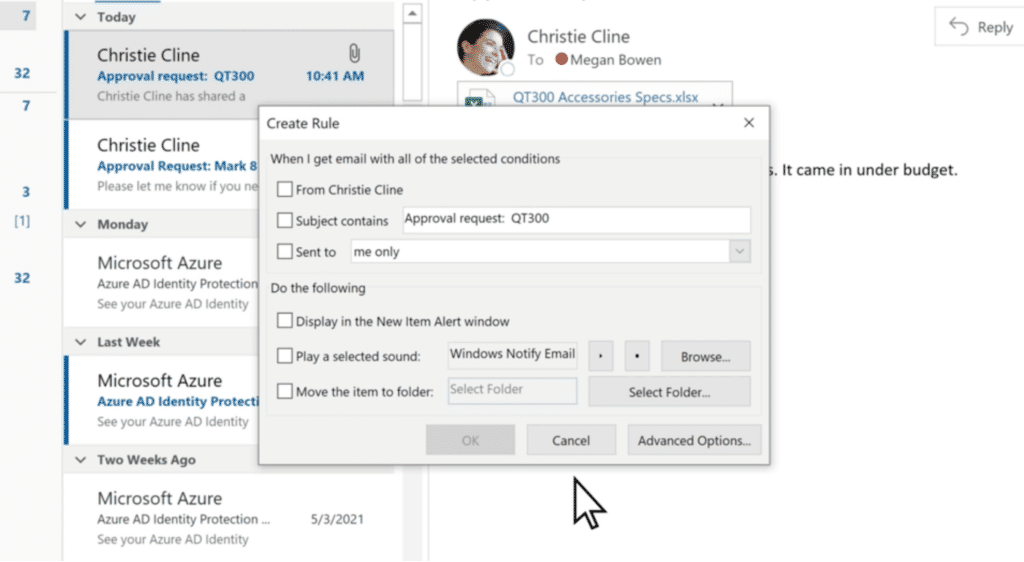
- Right-click an existing email and select Rules > Create Rule.
- Then select a condition and what to do with the email based on that condition.
For instance, to move messages with a certain title to a specific folder, select the Subject contains condition, select Move the item to folder, select or create a New folder, and then select OK. - When you’re done creating the rule, select OK.
Now you can prioritize important messages, filter out distractions, and keep your inbox clutter-free, all without lifting a finger.
2. Draft emails faster using Outlook’s My Templates feature
If you’re working in a department like customer support or human resources where a typical workday involves responding to people’s queries, you’d notice that a lot of these queries are similar. That’s where Outlook’s My Templates feature can help. It lets you create a canned response or a message template and just use that every time you get a commonly asked question.
You’ll save a lot of time and energy this way and you’ll also respond to the email much faster than if you were writing it from scratch or trying to locate the last email you’d sent so you can copy paste the response.
Here’s how you can create email templates in Outlook –
- Open a new email or reply to an existing email.
- Click on “View Templates” in the “My Templates” group.
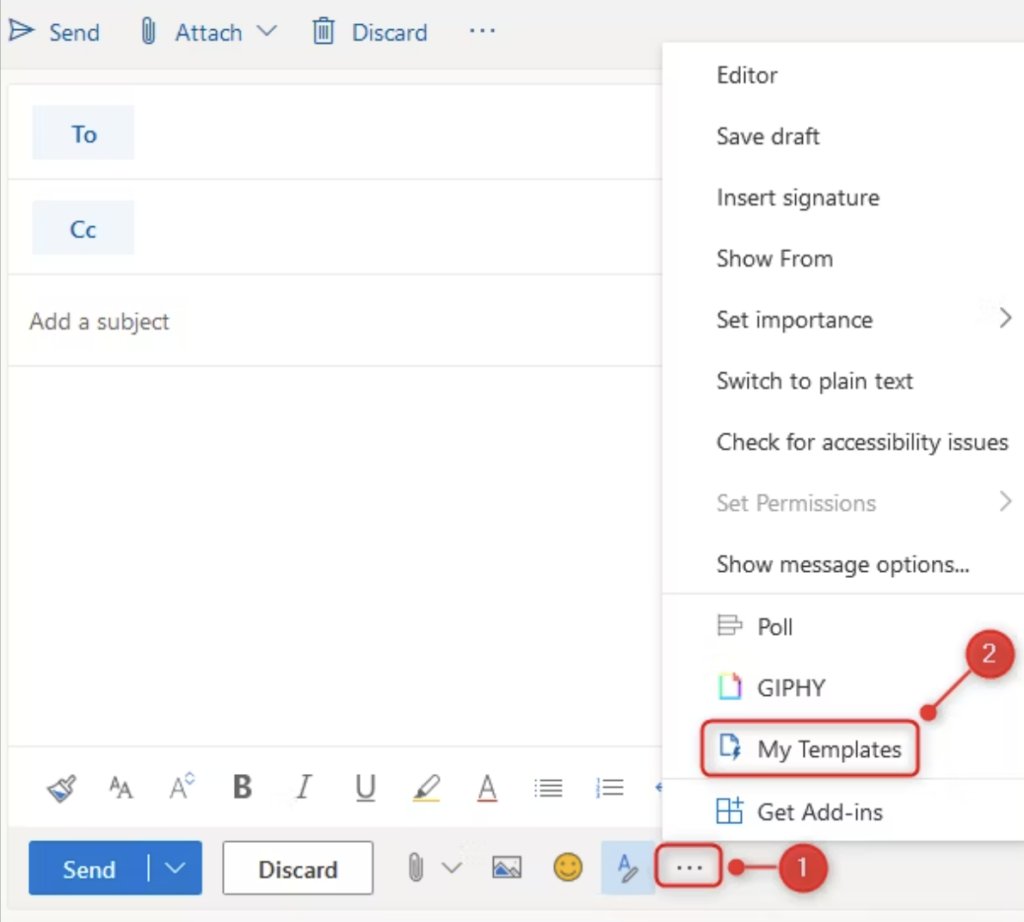
- In the “My Templates” pane that appears on the right, click on “+ Template”.
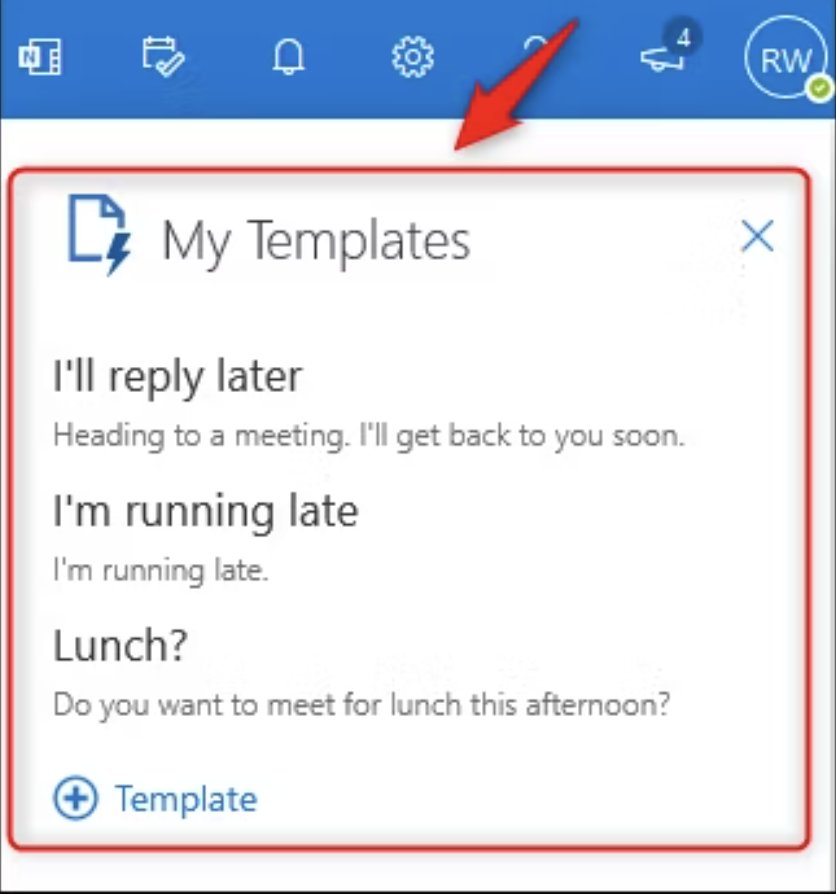
- Give your template a descriptive name and write the content you want to save.

- Click “Save” to store your template.
The next time you’re composing an email or replying to one, click on the template you want to use and the pre-written text will be inserted into your email. Customize the message as needed and send it out.
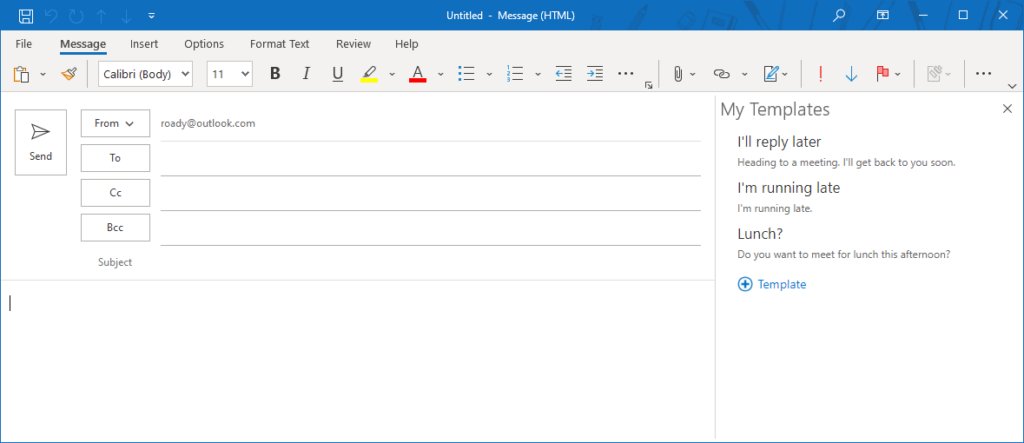
3. Use a Focused Inbox
Focused Inbox is a feature in Outlook that separates your inbox into two tabs – Focused and Other. The Focused tab contains the emails that matter most to you, based on your past interactions and the email content, while the Other tab contains the rest of your emails.
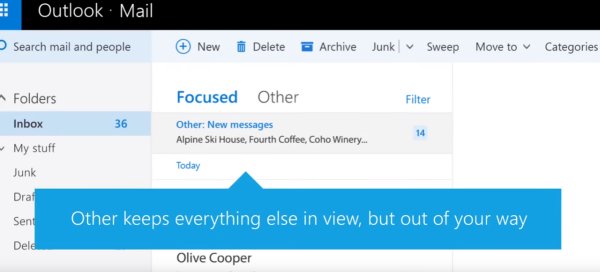
This feature allows you to quickly access important messages so that you don’t have to wade through a cluttered inbox.
Did you know: The more you use the Focused Inbox feature in Outlook, the smarter it gets. It pays attention to how you sort emails to better categorize incoming emails and help you focus and prioritize.
Here’s how to enable Focused Inbox –
Desktop App:
- Go to the “View” tab.
- Click on “Show Focused Inbox.”

Web App:
- Click on the gear icon (Settings) in the upper right corner.
- Toggle the “Focused Inbox” switch to “On.”
Once this is done, toggle to the ‘focused’ and ‘other’ views and move the emails from one view to another based on how important or relevant they are. This will help you train Outlook on which email you want in your Focused Inbox.
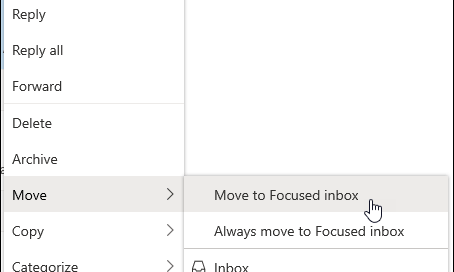
4. Learn Outlook shortcuts
Here’s another low-effort tip that will optimize the way you use Outlook on a daily basis. It’ll reduce the number of clicks and movements it takes to perform certain actions like replying to emails or forwarding an email. Here are some essential shortcuts you should know and use to begin with before you learn the more advanced ones:
| Action | Shortcut |
|---|---|
| Quickly open a new email message window | Ctrl + N |
| Instantly reply to the sender of the selected email | Ctrl + R |
| Respond to all recipients of the selected email | Ctrl + Shift + R |
| Forward the selected email to another recipient | Ctrl + F |
| Send the current email you are composing | Alt + S |
| Delete the selected email from your inbox | Del or Ctrl + D |
| Mark the selected email as read | Ctrl + Q |
| Open the search bar to find emails quickly | Ctrl + E |
| Create a new appointment in the calendar | Ctrl + Shift + A |
These are pretty simple to learn and implement. Trust me once you begin using these, there’s no going back. All Outlook-pros use shortcuts. Ask anybody working with any kind of software how easy using shortcuts makes your life, like designers for instance.
5. Customize your swipe options
This tip is for users that use Outlook on mobile devices like a phone or a tablet. You know how you swipe left or right on dating apps to decide on a potential match? You can do the same thing for emails on your mobile devices.
WIth the Outlook app on your phone, you can set-up personalized actions such as archiving, deleting, flagging, or marking emails as read/unread—with a simple swipe gesture. This reduces the need to navigate through menus and helps you quickly process emails, keeping your inbox tidy and manageable.
Here’s how to customize swipe options in Outlook –
- Launch the Outlook app on your mobile device.
- Tap on your profile icon or the gear icon (Settings) in the top-left or top-right corner.
- Scroll down and select “Swipe Options” under the “Mail” section.
- You will see options for “Swipe Right” and “Swipe Left.”
- Tap on each swipe direction to choose the desired action. Common options include – archive, delete, mark as read/unread and move to folder.
- After selecting your preferred actions for both swipe directions, close the settings menu to save your customizations.
6. Ignore conversations that aren’t relevant
One of the reasons our inboxes get so cluttered is because we get tagged in an email that’s not necessarily relevant to us anymore but because people in the thread are going back and forth.
A simple solution to proof yourself from this problem is to go to the email thread or conversation that you no longer wish to be a part of and right-click on it. Then click ignore.
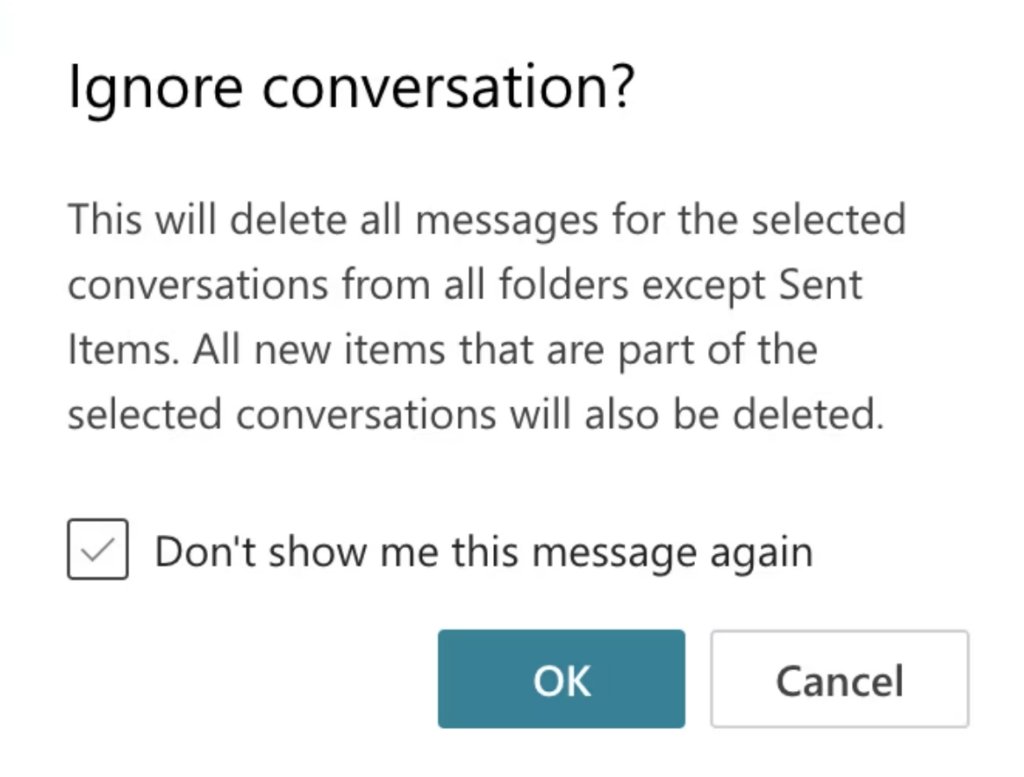
This will send all future replies to that thread directly to your Deleted Items folder instead of your inbox. This particular tip is something I really like because it saves me the hassle of removing a lot of emails from my inbox manually. My inbox stays quite clean and usually only contains stuff that needs my attention.
7. Catch up on your emails on the go
I’ll bet you didn’t know you could do this. You can use Microsoft’s productivity assistant Cortana to “talk to you”. Cortana is integrated into Outlook mobile and you can set up “Play your Emails” to have Cortana read out your emails to you
According to Microsoft’s community page – “Play My Emails starts with a summary – how many emails are new in your Focused Inbox in the last 24 hours and are there changes to your day? It’s helpful to know out of the gate if you’ll have time to listen to all your new emails as Cortana estimates the time it will take to read them out to you.
Based on Outlook’s integrated Calendar, Cortana first reads out messages that help you stay organized such as updates to scheduled events. Perhaps more importantly, Cortana also identifies if you have a conflict in your schedule due to the changes that may have just landed in your inbox.”
You can even talk to Cortana to unread, flag, delete or respond to emails.Think about how useful and time-efficient this feature can be during your commutes to work or when you’re taking a walk and want to check your email.
8. Use the do-not-disturb feature liberally
Look, there’s enough distractions while you’re working as it is. The last thing you need is more notifications informing you that there’s a new email in your inbox. So if you want to set aside some time where there are no distractions, I’d suggest using the do-not-disturb feature in Outlook.
The Do Not Disturb feature mutes email notifications during designated time periods, ensuring that you can work uninterrupted or enjoy personal time without the distraction of incoming emails. This can lead to improved concentration, better productivity, and reduced stress. You could use it for when you’re outside your working hours too!
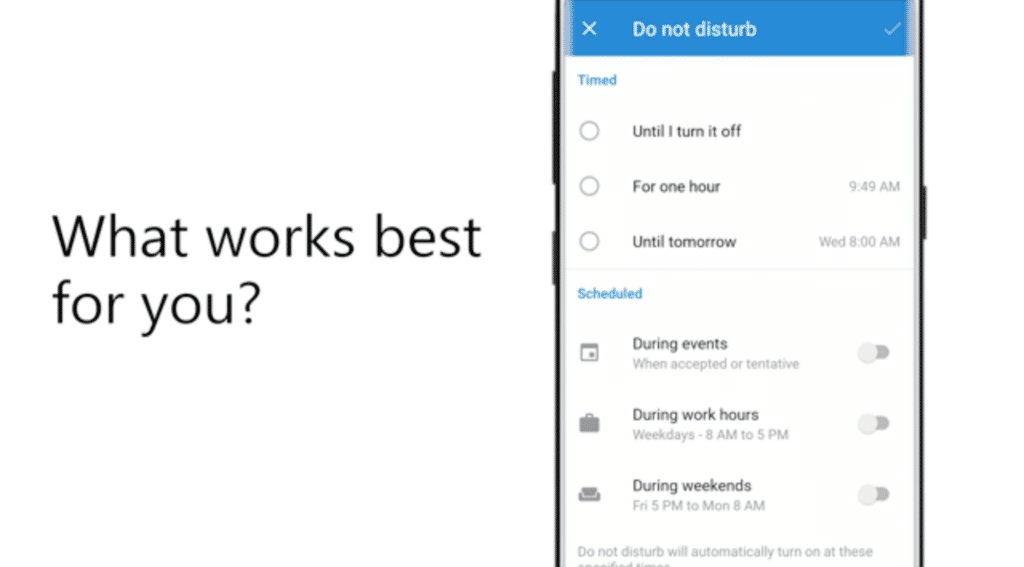
Here’s how to use it –
- Tap on your profile icon or the gear icon (Settings) in the top-left or top-right corner.
- Scroll down and select “Do Not Disturb” under the “Mail” section.
- Set up ‘do-not-disturb’.
- Scheduled: Tap on “Scheduled” to set up a recurring schedule for Do Not Disturb. Choose the start and end time for each day when you do not want to receive email notifications.
- Timed: Tap on “Timed” to activate Do Not Disturb for a specific duration, such as 1 hour, 2 hours, or until the next day.
- Custom: Tap on “Custom” to create a specific rule based on your needs, such as during meetings or while driving.
Toggle the switch to activate Do Not Disturb based on your selected options.
By effectively using Outlook’s Do Not Disturb feature, you can manage your email notifications more efficiently, allowing you to focus on your priorities and enhance your overall productivity.
9. Block Spam Email Senders
Blocking spam email senders helps you maintain a clean and efficient inbox, reducing distractions and the risk of phishing attacks or malware.
This way, you can focus on important communications and improve your overall productivity.
To block spammers here’s what you need to do –
- From the Home tab, select Junk.
- From here, choose ‘Junk E-mail’ Options.
- Find and click on the tab that says ‘Blocked Senders’.
- Press Add and Enter the email addresses you’d like to block.
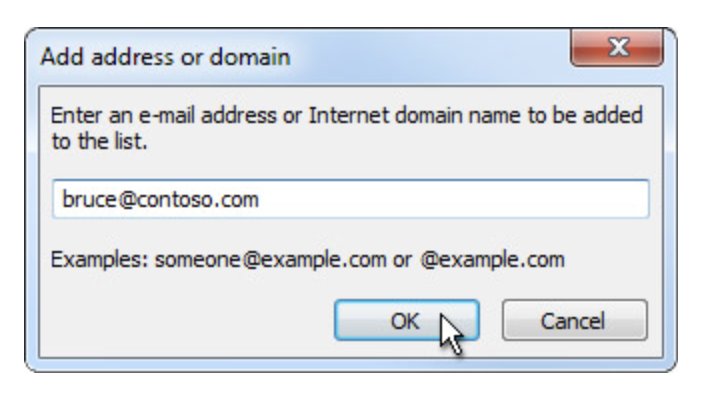
- Press OK and click Apply.
You’ll see a significant improvement in how less cluttered your inbox looks with this one simple step. Make sure you routinely block spam senders.
Wrapping Up
Remember that email is a facilitator for the work we do and not the actual work. It should be treated as such. We should use our inboxes and email as a way of enabling us to be more organized and communicate better. The last thing you and I want is for email to take up a significant chunk of our working hours. Not only is it stressful and annoying but it also majorly hinders productivity.
These strategies not only help you stay on top of your communications but also enhance your overall productivity and reduce the stress associated with a cluttered inbox. Whether you’re a busy professional, a student, or anyone who relies on email for daily communication, adopting these practices can make a significant difference in how you manage your time and tasks.














